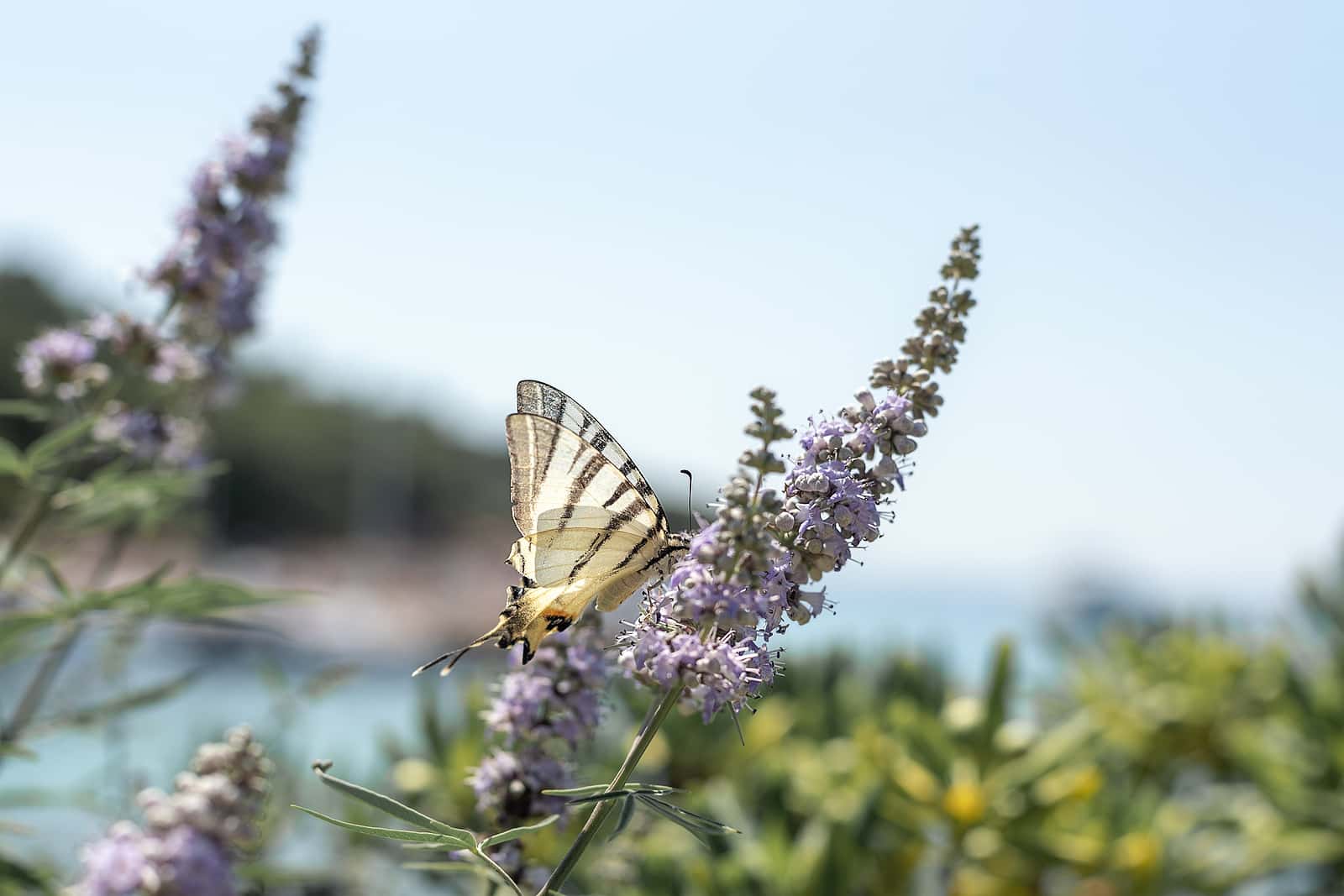
Vitex agnus-castus, also known as chaste tree, is a large shrub (up to twenty-two feet tall) native to the Mediterranean and southern Europe. Although it flourishes on moist riverbanks, it is easily grown as an ornamental plant in American gardens, where its attractive blue-violet flowers are appreciated in midsummer.
Why Is Vitex Called “Chaste Tree?”
The Greeks and Romans used this plant to encourage chastity and thought of it as capable of warding off evil. Medieval monks were said to use the dried berries in their food to reduce sexual desire. As a result, it was also referred to as “monks’ pepper.”
Hippocrates used chaste tree for injuries and inflammation. However, several centuries later, Dioscorides recommended it specifically for inflammation of the womb and also used it to encourage milk flow shortly after birth.
Contemporary Uses of Vitex:
Current use of chasteberry is almost exclusively for disorders of the female reproductive system. There is evidence that it can help alleviate symptoms of premenstrual syndrome (Archives of Women’s Mental Health, Dec. 2017). Some women take it to help control hot flashes ().
Oddly, the conditions for which it is most commonly recommended, premenstrual syndrome (PMS) and peri- or postmenopausal symptoms such as hot flashes, are associated with completely different hormonal imbalances.
Two authors publishing the results of a survey of medical herbalists were led by this observation to suggest that chaste tree may be an adaptogen, possibly affecting the pituitary gland.
Usually the dried berries are the part of the plant used. In some Mediterranean countries, leaves and flowering tops are also harvested and dried for use.
Active Ingredients
No one constituent of chaste tree has been isolated as responsible for its medicinal effects.
The berries contain iridoids as glycosides, including aucubin and agnuside.
Flavonoid content is highest in the leaves (up to 2.7 percent) and flowers (nearly 1.5 percent).
The berries contain almost 1 percent of flavonoids such as casticin, isovitexin, orientin, kaempferol, and quercetagetin.
It is perhaps surprising that chaste tree does not contain plant estrogens. Instead, progesterone, hydroxyprogesterone, testosterone, epitestosterone, and androstenedione have been identified in the leaves and flowers.
The essential oil of chasteberry may be responsible for its distinctive spicy aroma. It contains monoterpenes cineol and pinene, along with limonene, eucalptol, myrcene, linalool, castine, citronellol, and others, plus several sesquiterpenes.
Vitex agnus-castus also makes an alkaloid, vitricine.
Uses
Prolactin Reduction:
Animal research has shown that extracts of chaste tree berry have an effect on the pituitary gland of rats, reducing prolactin secretion. This has the impact of reducing milk production, exactly the opposite effect suggested by some of the ancient texts.
As a result of these studies, scientists have suggested using Vitex agnus-castus to treat conditions associated with excess prolactin. In a clinical trial of chasteberry for menstrual cycle abnormalities attributed to too much prolactin, the herb normalized both the cycle and the levels of prolactin and progesterone hormones.
Experts also believe it reduces premenstrual breast tenderness (Bratislavske Lekarske Listy, 2022).
Premenstrual Syndrome:
Several uncontrolled studies in Germany have shown that chaste tree extracts can reduce symptoms associated with PMS. In one of these studies, the investigators reported higher blood levels of progesterone as a result of treatment.
If Vitex agnus-castus can normalize hormone levels, it may be helpful for perimenopausal women with unusually short cycles or heavy bleeding. Dr. Susan Love considers that it may be worth a try.
Menopause:
No clinical studies to date have determined the effectiveness of chasteberry for menopausal symptoms, but many medical herbalists in the United Kingdom use it to treat hot flashes.
Infertility:
These practitioners also prescribe it for female infertility, but there are no data to indicate if chaste tree is helpful for this problem.
Although studies are lacking, the antiandrogenic effect of chaste tree berry is the rationale behind the use of this herb to treat acne in both men and women and its very occasional use to reduce an overactive libido.
Dose
The usual dose is 20 to 40 mg of the herb, or its equivalent.
If using a tincture, take 20 drops one or two times a day. Capsules or tea (one cup) may be used instead if it is more convenient.
Taking chasteberry shortly before bedtime may increase early morning melatonin secretion and improve sleep.
Vitex agnus-castus is slow acting. Two or three menstrual cycles, or a similar amount of time, may be needed to evaluate the effects.
A standardized product from Germany is available in the United States under the brand name Femaprin.
Special Precautions
Pregnant women should not take chaste tree berry.
Although one study indicated that this herb does not affect the composition of breast milk, nursing mothers are advised to avoid it. Despite its traditional use to increase milk production, the likelihood that the herb suppresses prolactin could make nursing more difficult.
Herbal practitioners may recommend that chaste tree berry not be used by women with hormone-sensitive cancers (breast, uterus). Anyone with such a serious condition should certainly be consulting an expert for advice before self-treating with any herb. Pituitary tumors also come into this category.
Adverse Effects
People don’t often report side effects, but some may experience itching and rash.
A few patients may experience mild nausea or headaches, especially when starting treatment.
Sometimes women discover that the length of their cycle has changed, and in rare cases women experience heavier menstrual periods. Overall, however, Vitex agnus-castus appears to be a reasonably safe herbal remedy (Drug Safety, 2005).
Possible Interactions
In general, chaste tree berry should not be combined with exogenous hormones such as oral contraceptives or menopausal hormone replacement therapies (Premarin, Prempro, Premphase, Provera, etc.).
Animal experiments indicate that compounds that act on dopamine in the brain may affect or be affected by the herb. Such drugs include Haldol, a medication for psychosis, L-Dopa or Parlodel for Parkinson’s disease, Wellbutrin for depression, or Zyban for quitting smoking.
No clinical consequences of interactions have been reported.

